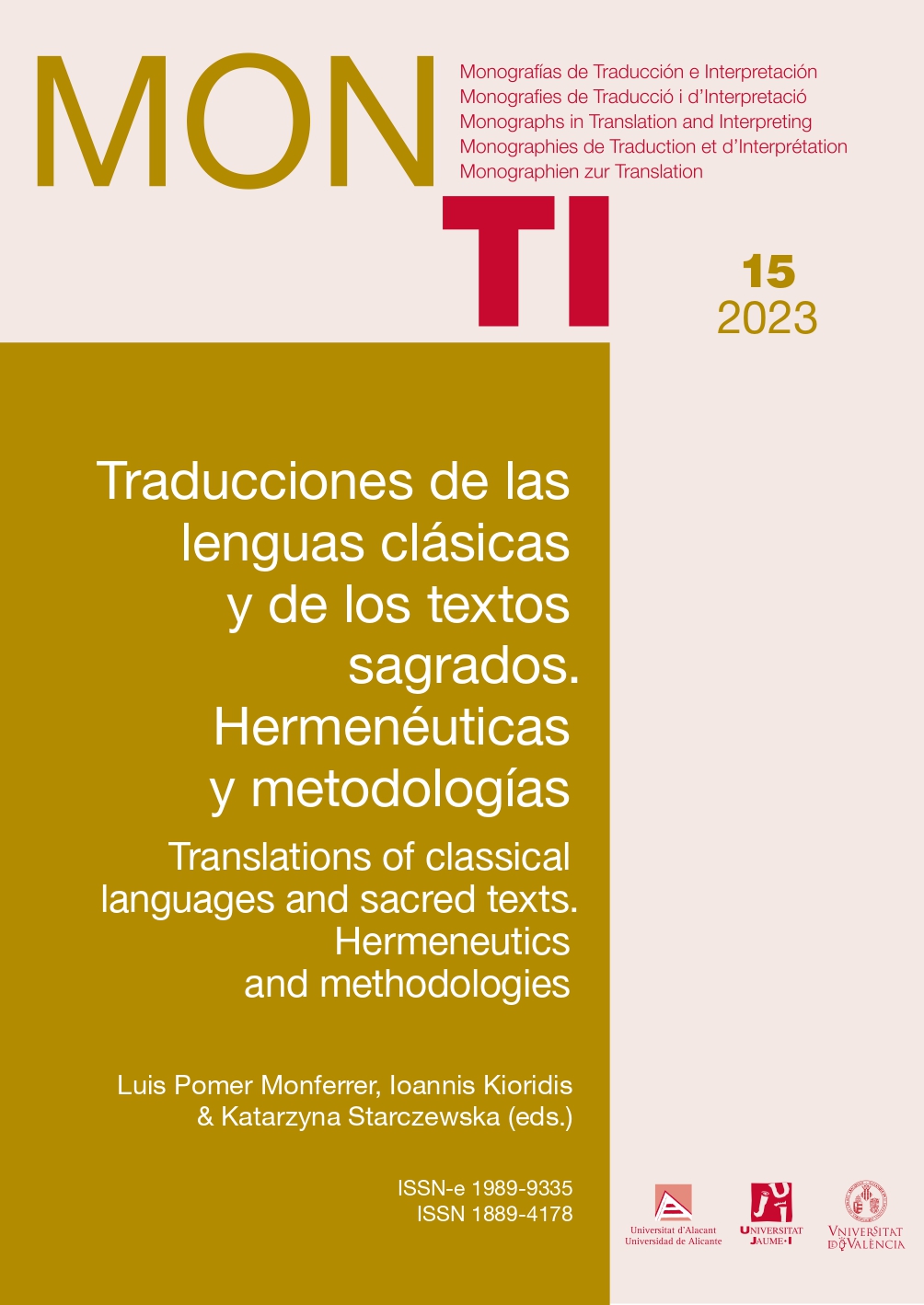Translators and the Sacred in Western Late Antiquity: Some Reflections
Main Article Content
Abstract
The aim of this paper is to reflect on the translation approach of two Latin authors of Late Antiquity, based on a series of their paratexts: Jerome (Ad Pammachium de optimo genere interpretandi, 57) and Calcidius (Introductory Epistle and preface of the Commentarius in Timaeum). Since both are dedicated to the translation of texts that could be considered “sacred” in Late Antiquity (the Bible, Plato’s Timaeus), their translation practices are mainly met with a tension between the poles of “tradition” and “innovation”, which can be re-read from a Translation Studies’ perspective through the categories of “fidelity” and “freedom” / “equivalence”. In short, what is at stake is the construction of discursive and moral authority (auctoritas), which guarantees the effectiveness of its task, on texts that project a particular character: the sacred.
Downloads
Article Details
The documents contained in these directories are included by the contributing authors as a means to ensure timely dissemination of scholarly and technical work on a non-commercial basis. It is understood that all persons copying this information will adhere to the terms and constraints invoked by each author's copyright. These works may not be reposted without the explicit permission of the copyright holder.
References
Fuentes primarias
BAKHOUCHE, Béatrice. (2011) Calcidius: Commentaire au Timée de Platon, v. 1-2. Paris: Les Belles Lettres.
BARTELINK, Gerhardus Johannes Marinus. (1980) Hieronymus. Liber de Optimo Genere Interpretandi (Epistula 57). Ein Kommentar. Leiden: E.J. Brill.
LABOURT, Jérôme. (1949) Saint Jérôme. Lettres. Edition and trnaslation. Paris: Collection des Universités de France
MAGEE, John. (2016) On Plato’s Timaeus. Calcidius. Harvard: Harvard University Press.
MACÍAS VILLALOBOS, Cristobal. (2014) Calcidio. Traducción y comentario del Timeo de Platón. Introducción, traducción y notas de C. Macías Villalobos. Zaragoza: Pórtico.
VALERO, Juan Bautista. (ed.) (1993) San Jerónimo. Epistolario. Madrid: BAC.
VEGA, Miguel Ángel. (1994) Textos clásicos de teoría de la traducción. Madrid: Cátedra
WASZINK, Jan Hendrik. (1962) Timaeus, a Calcidio translatus commentarioque instructus. Edición de Kiblansky. London & Leiden: Warburg Institute & Brill.
YON, Albert. (1964) De optimo genere oratorum / Du meilleur genre d’orateurs. Edición y traducción de A. Yon. Paris: Les Belles Lettres.
Referencias
ATHANASSIADI, Polymnia. (2005) La lutte pour l’orthodoxie dans le platonisme tardif. De Numenius á Damascius. Paris: Vrin.
BROCK, Sebastian. (1979) “Aspects of Translation Technique in Antiquity.” Greek, Roman and Byzantine Studies 20, pp. 69-87.
BROWN, Peter. (1997) El primer milenio de la cristiandad occidental. Barcelona: Laterza.
CAMERON, Averil. (1993/1998) El mundo mediterráneo en la Antigüedad Tardía (395-600). Barcelona: Crítica.
CAMERON, Alan. (1977) “Paganism and literature in late fourth century Rome.” Entretiens sur l’antiquité classique 23, pp. 1-40.
COPELAND, Rita. (1991) Rhetoric, Hermeneutics and Translation in the Middle Ages. Cambridge: Cambridge University Press.
COULTER, James A. (1976) The Literary Microcosm: Theories of Interpretation of the Later Neoplatonists. Leiden: Brill.
ELSNER, Jas & Jesús Hernández Lobato. (2017) The poetics of Late Latin Literature. Oxford: Oxford University Press.
EON, Alain. (1970) “La notion plotinienne d’exégèse.” Revue Internationale de Philosophie 92, pp. 253-289.
EVEN ZOHAR, Itamar. (1999) “La posición de la literatura traducida en el polisistema literario.” En: Iglesias Santos, Montserrat (coord.) 1999. Teoría de los Polisistemas. Madrid: Arco Libros, pp. 223-232.
FONTAINE, Jacques. (1977) “Unité et diversité du mélange des genres et des tons chez quelques écrivains latins du la fin du IV siècle: Ausone, Ambroise, Ammien.” Entretiens sur l’ antiquité classique 23, pp. 425-482.
GARCÍA JURADO, Francisco. (2007) “Símiles y metáforas de la erudición en Aulo Gelio.” Emerita: Revista de lingüística y filología clásica 75:2, pp. 279-298.
GARCÍA YEBRA, Valentín. (1994) Traducción: Historia y Teoría. Madrid: Gredos.
GINZBURG, Carlo. (2013) Mitos, emblemas e indicios. Buenos Aires: Prometeo.
GOULET-CAZÉ, Marie-Odile. (2000) Le commentaire, entre tradition et innovation. Paris: Vrin.
IGLESIAS SANTOS, Montserrat. (coord.) (1999) Teoría de los Polisistemas. Madrid: Arco Libros.
MACÍAS VILLALOBOS, Cristóbal. (2005) “Versiones Latinas del Timeo platónico.” Thamyris. Cuadernos de Filología Clásica núm. esp., pp. 151-175.
SCHWARZ, Werner. (1944) “The meaning of Fidus Interpres in Medieval Translation.” Journal of Theological Studies 45, pp. 73-78.
STEINER, George. (1997) Después de Babel. Aspectos del lenguaje y la traducción. México D.F.: FCE.
STRUCK, Peter. (2014) Birth of the Symbol, Ancient Readers at the Limits of their Texts. Princeton: Princeton University Press.
TOURY, Gideon. (1999) “La naturaleza y el papel de las normas en la traducción.” En: Iglesias Santos, Montserrat (coord.) 1999. Teoría de los Polisistemas. Madrid: Arco Libros, pp. 233-256.
VENUTI, Lawrence. (1992) Rethinking Translation: Discours, Subjectivity, Ideology. London: Routledge.


